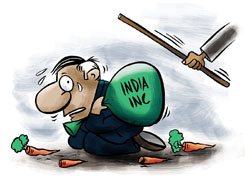Dear Sir
I have invested in a 2 BHK apartment in Mumbai Malad East area near Dindoshi court. The builder is GSA Grandeur. The builder promised to handover the flat possession ready to stay in December 2004. Later due to some issues he informed that the Flat shall be ready by December 2005. Now still he is saying that Falt shall be ready by August 2006. In this regard sir please advise what action I should take against the builder. The Flat cost is 1.11 CR plus registration charges from which I have paid him 1 CR. Kindly guide whom to approach for further action.
Regards
Ans: You have taken a major financial step by booking an apartment. I appreciate your initiative in seeking advice. As a Certified Financial Planner, here is a structured menu of action you can take — from validating your rights to escalating with the proper authorities. Make sure to review all your documents and decisions with a qualified property lawyer before proceeding further.
» Confirm the agreement details
Check your Agreement for Sale (or Contract) and note the promised possession date: you mention December 2004, then December 2005, and now August 2006.
Verify whether the builder (GSA Grandeur) / promoter has a registered project under MahaRERA (Real Estate Regulatory Authority, Maharashtra).
See whether the project is listed on the MahaRERA website with a registration number.
Check if the builder has issued written communications about delay and extensions (emails/letters) and whether they have acknowledged the original date and the subsequent revised date.
Retain all payment receipts (you paid Rs 1 Cr out of total Rs 1.11 Cr + registration) and keep a record of when each payment was made and as per which schedule of installments.
» Understand your legal rights under the law
Under the Real Estate (Regulation & Development) Act, 2016 (RERA) and corresponding Maharashtra rules, if a promoter delays handing over possession beyond the agreed time, you have a right to compensation or withdrawal (refund) as per Section 18 of the Act.
You may ask the builder to pay interest on the amount you have paid so far for the period of delay. The model agreement under Maharashtra RERA states that if the promoter is unable to deliver within the time-schedule, the promoter should pay interest for every month of delay.
If the builder fails to deliver within a “reasonable” extended time (or fails entirely), you can choose to withdraw and seek refund of your money, along with compensation.
If the project is not registered with RERA (even though it should have been), then you may have additional grounds for legal action under consumer law or contract law.
Please note: recent judgments highlight that the builder’s delay gives you rights; but home-loan interest you paid may not be fully refundable via consumer forum as per recent rulings.
» Immediate practical steps you should take
Write & send a formal letter (by registered post) to the builder (GSA Grandeur) stating:
You booked the 2 BHK apartment in Malad East near Dindoshi Court.
The agreed (original) possession date was December 2004 (as per the agreement) and subsequent revised dates.
You have paid Rs 1 Cr out of total Rs 1.11 Cr + registration charges.
You demand the builder to clearly state the revised firm date of handing over possession, or alternatively offer you the option to withdraw and refund the money if they cannot meet a firm date.
You seek interest on the amounts paid for the period of delay, as per model agreement and RERA provisions.
Keep all your communication in writing and copy all relevant documents: payment receipts, agreement, letters from builder, any announcements, etc.
Check whether the builder has applied for or received Occupancy Certificate (OC) or Completion Certificate for the project/phase. Without OC the handover is legally incomplete.
» Approach the regulatory and legal forums
Check on the MahaRERA website whether the project is registered and find the project registration number.
If registered, you can file a complaint with MahaRERA (Maharashtra Real Estate Regulatory Authority) under the Act. As per FAQs, you may approach them for a refund, compensation and interest for delay.
If the project is not registered or the builder is non-compliant, you may also consider filing a suit in the consumer forum or appropriate civil court/contract tribunal for breach of contract.
Before filing, consult a lawyer specialising in real estate/consumer law so that all your evidence and claims are framed properly.
» Evaluate your options: continue vs withdraw
If the builder now gives you a firm handover date (with OC, all works completed) then you may choose to continue, given that you have already invested a large sum.
However, if the builder is still giving vague dates (August 2006 or beyond) and there are no signs of progress (OC pending, works incomplete), then you should seriously consider withdrawal and refund.
In that event, you must ask for: full refund of amount paid, interest for delay period (and compensation if justified), plus possible damages for alternative accommodation/rent you may have taken.
Monitor whether the builder is proceeding with construction, obtaining approvals, and has conveyed clear timelines.
» Assessing risk & safeguarding yourself
Since you made the payment long ago and the possession is delayed significantly, there is time-value and risk involved.
Make sure your title rights are secure: the agreement must clearly state your unit, floor, parking (if any), and your payments.
Avoid making any further significant payments unless you receive a possession letter and builder gives you the keys and OC/occupancy certificate.
Check for any lien, mortgage or charge on the builder’s property which may delay transfer further.
Note that property/real estate is subject to large delays and builder insolvency risk; hence your proactive action is wise.
» Document checklist for your case
Agreement for Sale (signed by you and builder) with possession date clause.
Payment receipts/Cheque copies of your payments (1 Cr paid) and records of registration charges.
Written communications from builder about revised dates (December 2005, August 2006).
Project registration certificate on MahaRERA (if available).
Status of Occupancy Certificate / Completion Certificate for the building.
Construction status photographs, society formation records, if any.
Correspondence showing builder’s acknowledgment of delay or your demand for possession/refund.
Any rent/alternative accommodation expense you incurred due to delay (if applicable).
» Timeline of action
Immediately send the registered letter to builder demanding firm date or refund.
Within 1-2 months if builder does not respond with firm date, file complaint with MahaRERA or initiate legal action.
Keep monitoring builder’s progress; if there is substantial delay (many years beyond promised date) your case will become stronger.
Maintain all documents and remain proactive; deadlines and records matter in these matters.
» Final Insights
You have a strong basis to assert your rights. The fact that possession was promised years ago and is still delayed means you are well within your rights to demand either speedy handover or refund/compensation. Initiate formal written demand, verify builder registration under MahaRERA, maintain all records, and seek regulatory/legal redress if builder remains non-responsive. With the right approach and evidence, you can compel the builder to perform or compensate you. Your prompt action now will protect your investment and avoid further loss.
Best Regards,
K. Ramalingam, MBA, CFP,
Chief Financial Planner,
Holistic Investment Planners
www.holisticinvestment.in
https://www.youtube.com/@HolisticInvestment
























.jpg)
